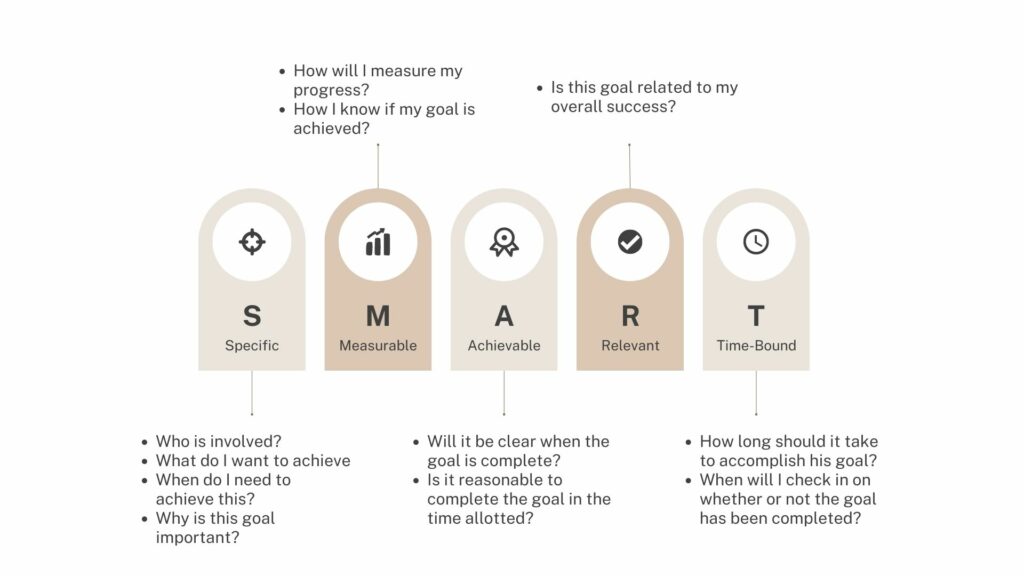Disclaimer: We sometimes use affiliate links in our content. For more information, visit our Disclaimer Page.
As a marketer, you’re always looking for new and innovative ways to reach your target audience. But before you can do that, you need to establish clear marketing objectives.
Without them, it isn’t easy to measure your success and gauge the effectiveness of your campaigns. This blog post will provide examples of effective marketing objectives, so you can start creating your own.
Remember that these are just suggestions; feel free to tailor them to fit your needs. So without further ado, let’s get started!
What are Marketing objectives?

Marketing objectives are the goals that a brand sets for its marketing activities. The objectives should be specific, measurable, achievable, relevant, and time-bound (SMART). This ensures that the marketing team can map out its efforts strategically and intentionally. The chosen objectives should also align with the brand’s overall business marketing goals.
Some common marketing objectives include increasing brand awareness, generating leads, boosting sales, and improving customer satisfaction. However, to be successful, marketers must ensure that they clearly understand their target audience and what they want to achieve.
Without this foundation, it will be challenging to create effective campaigns that resonate with consumers and help to reach the desired objectives.
Related: How to Generate Leads for Your Business
Why are marketing objectives important?
Marketing objectives are essential for several reasons. First, they provide a clear and concise way to measure customer acquisition. This is essential for any marketing team because it allows you to track your progress and determine whether or not your marketing strategy is working.
Additionally, marketing objectives add a level of accountability to your marketing team. Because they are so measurable, they naturally help you produce key performance indicators (KPIs) that can tell you if your team is working effectively or changes need to be made.
Ultimately, marketing objectives are important because they help you track progress, measure success, and hold your marketing team accountable for results.
Related: Monitoring Sales: How to Measure KPIs
Top 8 Common Marketing Objective Examples
Whether you’re a big or small company, here are eight marketing objective examples to get you started.
1. Increasing brand awareness

A key objective for many businesses is to increase awareness of their brand. Many marketing objectives can help increase brand awareness for your business. By targeting specific audiences and using effective marketing strategies, you can reach more people with your message and build name recognition for your company.
Some common marketing objectives that can help increase brand awareness include:
- Developing an advertising campaign that targets a specific audience.
- Use search engine optimization (SEO) to make your website more visible in search results.
- Engaging in social media marketing to build relationships with potential and current customers.
- Create informative and interesting blog content that will attract the attention of your target audience.
- Participating in tradeshows and other events that your target market will be attending.
- Conduct market research to learn more about your target audience and what they are looking for.
Developing a well-rounded marketing strategy that includes a mix of these objectives can help you reach more people with your message and increase brand awareness for your business.
2. Generating leads
Generating new leads is another common marketing objective that creates compelling offers and drives traffic to a landing page. Effective marketing campaigns will include measurable marketing objectives such as website traffic or conversion rate so that the campaign results can be tracked and analyzed.
Businesses can increase the chances of converting visitors into leads by driving targeted website traffic to a landing page. In addition, companies can incentivize potential customers to provide their contact information by offering a valuable product or service. By generating new leads, businesses can expand their marketing efforts and reach a wider audience.
3. Improving conversion rates
Once leads have been generated, the next objective is often to convert them into customers. This can be done by optimizing the sales process and ensuring that the right offers are made at the right time.
Client relationship management software can help sales teams keep track of interactions with leads and customers and ensure that follow-up calls and emails are made in a timely manner. In addition, existing customers can be a valuable source of referrals, so it’s important to nurture those relationships.
Finally, remember that new customers are not always the best; sometimes, it’s more profitable to focus on selling additional products or services to existing ones. By considering these factors, businesses can improve their conversion rates and increase their bottom line.
4. Increasing customer loyalty
Customer loyalty is essential for any business that wants to succeed in the long term. But what exactly is customer loyalty, and how can companies increase it?
It can be defined as the extent to which customers are willing to continue doing business with a company, despite changes or challenges.
Increasing customer loyalty requires marketing efforts that nurture leads and convert them into customers and marketing initiatives that keep existing customers engaged.
5. Increasing revenues
One of the ultimate goals of any business is to increase revenues. This can be done by growing the customer base and/or increasing average order values.
The sales department is responsible for generating qualified sales leads, which are potential customers that have been screened and determined to be likely to make a purchase.
The marketing department then develops a successful marketing strategy to convert those leads into customers. As a result, businesses can increase their revenues by increasing the number of sales-qualified leads and successfully converting them into customers.
6. Decreasing costs
Any business owner knows that one of the most important objectives is to reduce costs. This can be done in various ways, such as automating processes, streamlining operations, and negotiating better supplier deals. In many cases, reducing costs is a matter of increasing efficiency and eliminating waste.
For example, by automating processes, businesses can eliminate the need for manual labor, saving time and money. Similarly, streamlining operations can help to minimize delays and errors, resulting in more efficient use of resources.
Finally, negotiating better deals with suppliers can help to lower the cost of essential materials and services. By reducing costs in these and other ways, businesses can improve their bottom line and become more successful.
7. Expanding into new markets
Many businesses have the objective of expanding into new markets. This can be done through market research, target marketing, and effective positioning. Market research entails understanding the needs and wants of potential customers in a given market. It also involves understanding these customers’ buying habits and the competition in the market.
Target marketing is the process of identifying a target market and then developing a marketing mix tailored to that market. Effective positioning involves creating a unique selling proposition that differentiates a company’s products or services from its competitors. Expanding into new markets can be a great way to grow a business.
However, it is vital first to understand potential customers’ needs and the competition in the targeted market. Only then can a company develop an effective marketing strategy that will allow it to expand into new markets successfully.
8. Launching new products or services
Launching new products or services is another common objective for businesses. It can be done through market research, product development, and effective marketing. Market research helps companies identify customer needs and wants.
Product development involves creating products that meet those needs and wants. And finally, effective marketing is essential to make customers aware of the new product or service and encourage them to buy it. When launching a new product or service, it is important to consider all three elements to succeed.
These are just a few examples of common marketing objectives. There are many others that businesses may set, depending on their specific needs and goals. But whatever objectives are set, it’s crucial to have a clear plan for achieving them. Otherwise, all the marketing activities in the world won’t matter if they’re not aligned with the business’s overall objectives.
Related: How to Promote Your Business Locally
How To Write Marketing Objectives?

Now that we’ve gone over some marketing objectives examples let’s discuss how to write them. There are a few things to keep in mind when writing marketing objectives:
1. Be specific
When writing marketing objectives, it’s important to be as specific as possible. This means clearly stating what you want to achieve and providing measurable targets. For example, rather than saying you want to “increase sales,” you could say you want to “increase sales by 10%.” This is a much more specific and measurable goal.
2. Make them achievable
It’s also important to make sure your marketing objectives are achievable. There’s no point in setting goals that are impossible to reach. Not only will you be setting yourself up for failure, but you’ll also demotivate your team. So setting goals that challenge your team but are still achievable is essential.
3. Align them with your overall business objectives
Finally, ensure your marketing objectives align with your overall business objectives. This means ensuring that they support and further your business goals. For example, if your goal is to increase market share, your marketing objectives should focus on activities that will help you achieve this.
4. Set a timeframe
When writing marketing objectives, it’s also important to set a timeframe. This will help you measure whether you’re on track to achieve your goals. For example, rather than saying, “We have to increase sales,” you could say you want to “increase sales by 15% within the next year.” This provides a clear timeframe for measuring progress and determining whether or not the goal has been met.
5. Set price targets
As you develop your business plan and begin to form strategies for marketing and pricing your product or service, it is crucial to set a price target. This will help you determine your positioning in the market and what price point will be most competitive and advantageous for your product.
It can be helpful to do some research on your competitors’ prices, as well as what consumers in your target market are willing to pay. Then, once you understand the market landscape, you can set a goal for where you would like your prices to be.
For example, if you are currently priced lower than most of your competitors, you may want to increase your prices by 10% each year until you reach your target price point. Conversely, if you are currently priced higher than desired, you may need to decrease prices gradually over time.
No matter what route you take, setting a price target will give you a clear goal to strive for as you continue to grow and develop your business.
Related: Business Marketing Plan
Final Thoughts
Marketing objectives are essential for any business that wants to be successful. However, without clear and achievable goals, measuring progress and determining whether or not your marketing efforts are paying off will be difficult.
When writing marketing objectives, it’s important to be as specific as possible, ensure they are achievable, and align them with your overall business objectives. You should also set a timeframe and price targets to help you measure progress and stay on track.
What are your thoughts on marketing objectives? Let us know in the comments below!
FAQ
What are some good marketing objectives?
Some good marketing objectives include increasing sales by 10%, increasing market share by 5%, and launching a new product or service.
How do I write a marketing objective?
When writing a marketing objective, you should be specific, achievable, and aligned with your overall business objectives. You should also set a timeframe and price targets to help you measure progress and stay on track.
What is the difference between a goal and an objective?
A goal is a broad statement of what you want to achieve, while an objective is a specific, measurable target that supports the goal. For example, “increasing sales” could be a goal, while “increasing sales by 10%” could be an objective.
What are some examples of marketing objectives?
Some examples of marketing objectives include increasing sales, increasing market share, launching a new product or service, and improving customer satisfaction.
How do I set marketing objectives?
When setting marketing objectives, you should consider your overall business objectives and what you want to achieve with your marketing efforts. You should also set a timeframe and price targets to help you measure progress and stay on track.
What are Marketing qualified leads?
A qualified marketing lead (MQL) is a prospective customer who has been identified as more likely to buy a product or service than other leads. MQLs are typically generated through marketing campaigns, such as website visitor tracking or lead nurturing programs.
What is meant by KPI?
Key performance indicators (KPI) are a set of quantifiable measures that a company uses to gauge its performance over time. KPIs are relevant to all aspects of a business, from sales and marketing to product development and customer service.
What is a SMART marketing objective?
Strategic marketing is the process of developing a comprehensive marketing plan that aligns with the company’s overall business strategy. Strategic marketing aims to create a unified and coordinated approach to all of the company’s marketing activities so that each activity works towards the same objectives.
What is meant by strategic marketing?
Strategic marketing is the process of developing a comprehensive marketing plan that aligns with the company’s overall business strategy. Strategic marketing aims to create a unified and coordinated approach to all of the company’s marketing activities so that each activity works towards the same objectives.
What is a market analysis?
A market analysis studies a given market’s size, scope, and potential. Market analyses are used to identify opportunities and assess the viability of marketing campaigns. They can also be used to monitor changes in the market over time.





